What Ole Gunnar Solskjaer tried to do against Liverpool, why it worked and what else he could have done
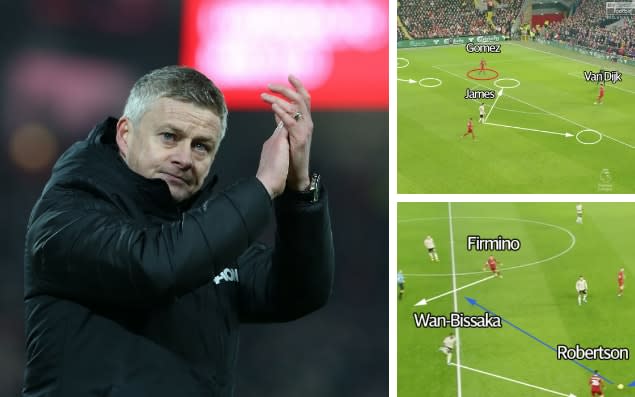
Roy Keane was concerned by Manchester United’s starting lineup. “The closer we get to kick-off the more worried I am,” the club’s former captain admitted when commenting on an XI featuring two left-backs, missing its best attacking player and with a midfield trio unlikely to survive beyond the summer.
United are an upper mid-table side with a Real Madrid wage bill. Their players aren’t any better than those at Wolves and they’ve won a game more than Sheffield United, but the name ‘Manchester United’ means those picked to play are expected to at least challenge a club like arch rivals Liverpool, the current world champions. For large spells of the game, they did.
With all things considered, should Ole Gunnar Solskjaer have been expected to do better than the 2-0 defeat on Sunday?
What Manchester United needed to plan for
Ole Gunnar Solskjaer’s list of problems to solve before the match on Sunday included:
How to beat a team which had won 30 of its previous 31 league matches
How to score against a defence which hadn’t conceded in six games
How to achieve this with a team second best in every position - and without key individuals
How to defend against specific threats and offer counter-attacking potential
How to prevent Trent Alexander-Arnold's creative influence and stop Andy Robertson causing overloads
United took a point from their last match against Liverpool by setting up in a 3-4-1-2, deploying two wing-backs to push high on opposition full-backs and limit their creative capacity, absorb pressure and hit them on the break. That same plan couldn't be relied upon to work again, especially considering the tactical changes Jurgen Klopp enacted after that 1-1 draw, having his players regularly rotate positions to avoid being marked out of the game as United did.
How Manchester United attempted to keep Liverpool quiet
United lined up as a 4-2-3-1 which defended as a 5-2-1-2 or 5-3-2, depending on phase of play. Regardless of numerical formation, the team was composed of three centre-backs vs three Liverpool forwards, wing-backs vs advanced full-backs, a midfield designed to screen the defence and shift the ball to the forwards quickly, and two pacy forwards (Anthony Martial and Dan James) looking to exploit Liverpool's full-backs moving up the pitch.
Below, United press high up the pitch in a 5-2-1-2 shape. Martial and James can easily sprint to block a passing lane to a midfielder or wide player, discouraging the short pass to force a long ball, or encouraging a risky pass that can be intercepted.
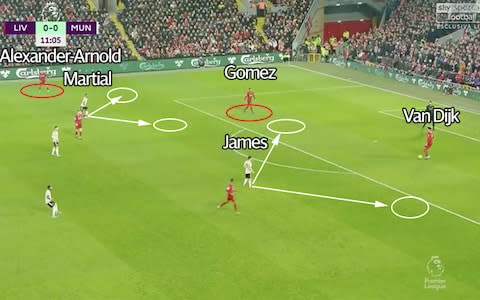
Brandon Williams was a surprise inclusion, starting wide of Luke Shaw as both defensive winger and wing-back tasked with keeping Alexander-Arnold quiet. The Liverpool full-back often drifts in-field or overlaps, which is difficult to defend against in a zonal system - assigning Williams to mark him eliminates any confusion when Liverpool attack.
In the example above, Williams is (off screen) in a wing-back position closer to half way to help Shaw deal with any long pass sent towards Mohamed Salah on the left wing.
If Liverpool don't go long and the pass goes short to Alexander-Arnold, Williams then has time to sprint and close him down, making it difficult for Liverpool to progress.
Below, United follow the ball back towards the Liverpool box. Although James is in position, he doesn't press with the intensity and conviction needed, understandable after a hectic opening 15 minutes.

James doesn't block the space which leaves the pass to Robertson at left-back open. Van Dijk plays it wide. This prompts Wan-Bissaka to leave his position to close down Robertson, which leaves space for Roberto Firmino to move into and gives Robertson an easy diagonal passing option.
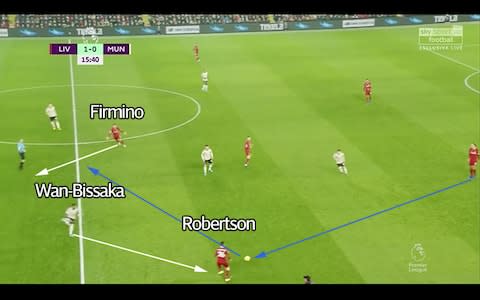
Wan-Bissaka is seriously quick though and shuts down Robertson before he can make the pass, forcing play all the way back to Alisson. The press works.
Liverpool reacted to being shut down high up the pitch by dropping even deeper to build from the back, creating wider angles that meant James and Martial's pressing was made redundant. Below, Van Dijk receives a goal kick near the byline, which gives him an easier/wider pass into Robertson to his left. Gini Wijnaldum is another near option should James race to close the pass to Robertson.
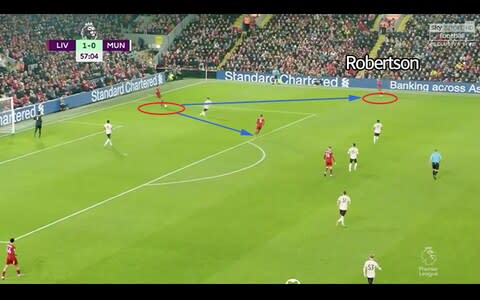
The ball goes straight to Robertson which, as before, means Wan-Bissaka needs to close him down. He does, but Robertson has time to lift a pass towards Sadio Mane on the left wing.
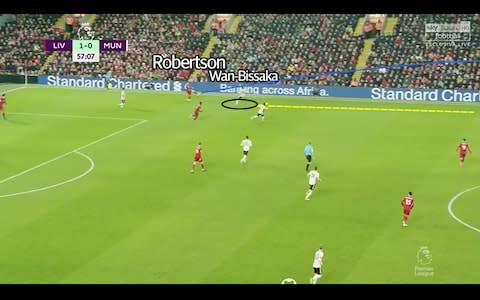
Wan-Bissaka leaving the right-back space to close down Robertson means United's centre-backs have to shift over to cover.
Mane receives the ball with his back to goal, Victor Lindelof gets tight, Harry Maguire moves over, and behind this Luke Shaw (in the centre-circle) drops deeper into a central sweeper position.

United's defence blocks the danger areas in a highly choreographed manner and Liverpool's attack comes to nothing.
The shape and pressing plan made total sense. The problem was occasional lapses in concentration from United's players, a loose pass spoiling moves in the final third and at its most basic, how good Liverpool are.
How it almost worked
"I think they’ve stamped their authority on the game, they're leading the league deservedly," said Solskjaer after the match. "[They're] the most direct team in the league, they play long balls, second balls - it’s not like they carve you open, they played through us. I think today was much better than last year."
The best United could do in preparation was find ways to control the things they could, and if things went their way, take any chances created. Liverpool were always going to find ways to shoot, but that they only scored from a marking mis-match and poor individual defending at a corner is testament to how well, relatively speaking, United did at limiting their attacking options.
Things would have been entirely different had Martial's one-two on the edge of the area resulted in an equaliser, an opportunity created by clever link play and individual flair supported by United's attacking shape around the box. Solskjaer's planning helped his side create this chance.
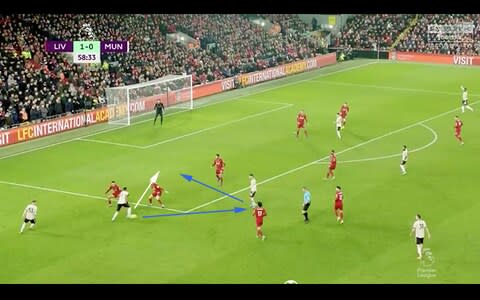
Above, Williams makes an overlapping run to distract right-back Alexander-Arnold. Wan-Bissaka takes up position wide right (arm up on the edge of the box) to stretch the defence. Martial (on the ball) and James (in the box) are split in half spaces between full-back and centre-back rather than marked by a centre-back. Andreas Pereira has dropped into the 10 space on the edge of the box to link play with Martial. Fred and Nemanja Matic are in supporting cover positions. United have three centre-backs further back to protect against Mane and Salah in the event of a counter.
Martial plays the first pass and darts into the space between full-back and centre-back, Pereira flicks the ball through and Martial blazes over from 12 yards. Failing to take these chances is the difference between getting a result and not in matches against vastly superior opponents - just because the team lost does not mean the manager got the approach wrong.
What else could Solskjaer have done?
Poor recruitment and scattered long term strategy has left faults in the foundations that Solskjaer and his staff are trying to address, but until this is fixed the manager can only work with what's available. United aren't a bad team but there is a marked difference in quality of player between their squad and Liverpool's which demands appropriate shifts in match strategy. Even Manchester City don't opt for their attacking, possession-based 4-3-3 against Liverpool for fear of defeat.
Watford sat deep and defended against Manchester United in their 2-0 win because it was the approach most likely to prevent them conceding goals and allowed for chances created on the counter-attack. United have to prepare for games against Liverpool, Manchester City, Leicester and Chelsea in the same manner.
Solskjaer is trying to change the culture at the club by bringing in young, energetic players determined to reach a higher level as opposed to hired mercenaries, and re-establish a playing style that has been mangled by various managers and romanticised by impatient supporters. Without players capable of performing in this way, the team can only ever function below 100 per cent, which is why United are trapped in their upper mid-table purgatory. With time, focused recruitment and coaching this can be addressed.
As we've seen with Liverpool's patient rebuild, if this transitional period is managed correctly and those in charge stick to the plan and let the garden grow, the rewards are absolutely worth waiting for. Until then, no matter who is in charge at United, they will be forced to play as though second best against teams they usually consider their equal.

